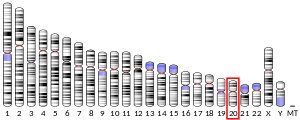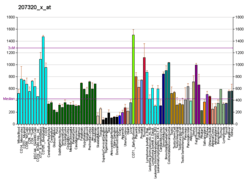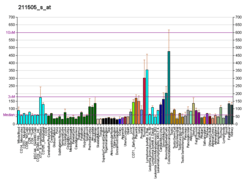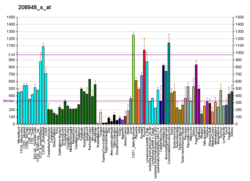STAU1
Double-stranded RNA-binding protein Staufen homolog 1 is a protein that in humans is encoded by the STAU1 gene.[5][6][7]
Staufen is a member of the family of double-stranded RNA (dsRNA)-binding proteins involved in the transport and/or localization of mRNAs to different subcellular compartments and/or organelles. These proteins are characterized by the presence of multiple dsRNA-binding domains which are required to bind RNAs having double-stranded secondary structures. The human homologue of staufen encoded by STAU, in addition contains a microtubule-binding domain similar to that of microtubule-associated protein 1B, and binds tubulin. The STAU gene product has been shown to be present in the cytoplasm in association with the rough endoplasmic reticulum (RER), implicating this protein in the transport of mRNA via the microtubule network to the RER, the site of translation. Five transcript variants resulting from alternative splicing of STAU gene and encoding three isoforms have been described. Three of these variants encode the same isoform, however, differ in their 5'UTR.[7]
STAU1 is associated with stress granules.[8]
References
- GRCh38: Ensembl release 89: ENSG00000124214 - Ensembl, May 2017
- GRCm38: Ensembl release 89: ENSMUSG00000039536 - Ensembl, May 2017
- "Human PubMed Reference:". National Center for Biotechnology Information, U.S. National Library of Medicine.
- "Mouse PubMed Reference:". National Center for Biotechnology Information, U.S. National Library of Medicine.
- DesGroseillers L, Lemieux N (Feb 1997). "Localization of a human double-stranded RNA-binding protein gene (STAU) to band 20q13.1 by fluorescence in situ hybridization". Genomics. 36 (3): 527–529. doi:10.1006/geno.1996.0499. PMID 8884277.
- Kim YK, Furic L, Desgroseillers L, Maquat LE (Jan 2005). "Mammalian Staufen1 recruits Upf1 to specific mRNA 3'UTRs so as to elicit mRNA decay". Cell. 120 (2): 195–208. doi:10.1016/j.cell.2004.11.050. PMID 15680326.
- "Entrez Gene: STAU1 staufen, RNA binding protein, homolog 1 (Drosophila)".
- Thomas MG, Martinez Tosar LJ, Loschi M, Pasquini JM, Correale J, Kindler S, Boccaccio GL (January 2005). "Staufen recruitment into stress granules does not affect early mRNA transport in oligodendrocytes". Molecular Biology of the Cell. 16 (1): 405–420. doi:10.1091/mbc.E04-06-0516. PMC 539183. PMID 15525674.
Further reading
- Kiebler MA, DesGroseillers L (2000). "Molecular insights into mRNA transport and local translation in the mammalian nervous system". Neuron. 25 (1): 19–28. doi:10.1016/S0896-6273(00)80868-5. PMID 10707969.
- Marión RM, Fortes P, Beloso A, et al. (1999). "A human sequence homologue of Staufen is an RNA-binding protein that is associated with polysomes and localizes to the rough endoplasmic reticulum". Mol. Cell. Biol. 19 (3): 2212–2219. doi:10.1128/mcb.19.3.2212. PMC 84014. PMID 10022908.
- Wickham L, Duchaîne T, Luo M, et al. (1999). "Mammalian staufen is a double-stranded-RNA- and tubulin-binding protein which localizes to the rough endoplasmic reticulum". Mol. Cell. Biol. 19 (3): 2220–2230. doi:10.1128/mcb.19.3.2220. PMC 84015. PMID 10022909.
- Falcón AM, Fortes P, Marión RM, et al. (1999). "Interaction of influenza virus NS1 protein and the human homologue of Staufen in vivo and in vitro". Nucleic Acids Res. 27 (11): 2241–2247. doi:10.1093/nar/27.11.2241. PMC 148787. PMID 10325410.
- Mouland AJ, Mercier J, Luo M, et al. (2000). "The double-stranded RNA-binding protein Staufen is incorporated in human immunodeficiency virus type 1: evidence for a role in genomic RNA encapsidation". J. Virol. 74 (12): 5441–5451. doi:10.1128/JVI.74.12.5441-5451.2000. PMC 112028. PMID 10823848.
- Wiemann S, Weil B, Wellenreuther R, et al. (2001). "Toward a catalog of human genes and proteins: sequencing and analysis of 500 novel complete protein coding human cDNAs". Genome Res. 11 (3): 422–435. doi:10.1101/gr.GR1547R. PMC 311072. PMID 11230166.
- Deloukas P, Matthews LH, Ashurst J, et al. (2002). "The DNA sequence and comparative analysis of human chromosome 20". Nature. 414 (6866): 865–871. doi:10.1038/414865a. PMID 11780052.
- Monshausen M, Rehbein M, Richter D, Kindler S (2002). "The RNA-binding protein Staufen from rat brain interacts with protein phosphatase-1". J. Neurochem. 81 (3): 557–564. doi:10.1046/j.1471-4159.2002.00887.x. PMID 12065664.
- Luo M, Duchaîne TF, DesGroseillers L (2002). "Molecular mapping of the determinants involved in human Staufen-ribosome association". Biochem. J. 365 (Pt 3): 817–824. doi:10.1042/BJ20020263. PMC 1222739. PMID 12133005.
- Ohashi S, Koike K, Omori A, et al. (2002). "Identification of mRNA/protein (mRNP) complexes containing Puralpha, mStaufen, fragile X protein, and myosin Va and their association with rough endoplasmic reticulum equipped with a kinesin motor". J. Biol. Chem. 277 (40): 37804–37810. doi:10.1074/jbc.M203608200. PMID 12147688.
- Angenstein F, Evans AM, Settlage RE, et al. (2002). "A receptor for activated C kinase is part of messenger ribonucleoprotein complexes associated with polyA-mRNAs in neurons". J. Neurosci. 22 (20): 8827–8837. doi:10.1523/jneurosci.22-20-08827.2002. PMID 12388589.
- Strausberg RL, Feingold EA, Grouse LH, et al. (2003). "Generation and initial analysis of more than 15,000 full-length human and mouse cDNA sequences". Proc. Natl. Acad. Sci. U.S.A. 99 (26): 16899–16903. doi:10.1073/pnas.242603899. PMC 139241. PMID 12477932.
- Macchi P, Kroening S, Palacios IM, et al. (2003). "Barentsz, a new component of the Staufen-containing ribonucleoprotein particles in mammalian cells, interacts with Staufen in an RNA-dependent manner". J. Neurosci. 23 (13): 5778–5788. doi:10.1523/jneurosci.23-13-05778.2003. PMID 12843282.
- Ota T, Suzuki Y, Nishikawa T, et al. (2004). "Complete sequencing and characterization of 21,243 full-length human cDNAs". Nat. Genet. 36 (1): 40–45. doi:10.1038/ng1285. PMID 14702039.
- Chatel-Chaix L, Clément JF, Martel C, et al. (2004). "Identification of Staufen in the human immunodeficiency virus type 1 Gag ribonucleoprotein complex and a role in generating infectious viral particles". Mol. Cell. Biol. 24 (7): 2637–2648. doi:10.1128/MCB.24.7.2637-2648.2004. PMC 371130. PMID 15024055.
- Villacé P, Marión RM, Ortín J (2004). "The composition of Staufen-containing RNA granules from human cells indicates their role in the regulated transport and translation of messenger RNAs". Nucleic Acids Res. 32 (8): 2411–2420. doi:10.1093/nar/gkh552. PMC 419443. PMID 15121898.
- Colland F, Jacq X, Trouplin V, et al. (2004). "Functional proteomics mapping of a human signaling pathway". Genome Res. 14 (7): 1324–1332. doi:10.1101/gr.2334104. PMC 442148. PMID 15231748.
- Brendel C, Rehbein M, Kreienkamp HJ, et al. (2005). "Characterization of Staufen 1 ribonucleoprotein complexes". Biochem. J. 384 (Pt 2): 239–246. doi:10.1042/BJ20040812. PMC 1134106. PMID 15303970.






